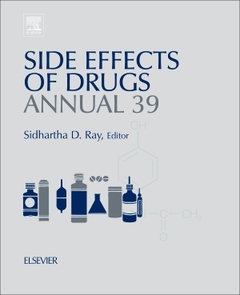Description
Side Effects of Drugs Annual
A Worldwide Yearly Survey of New Data in Adverse Drug Reactions
Language: English
Support: Print on demand
Description
/li>Contents
/li>Readership
/li>Biography
/li>Comment
/li>
Side Effects of Drugs Annual: A Worldwide Yearly Survey of New Data in Adverse Drug Reactions, Volume 39 presents the latest on a variety of topics, with new chapters in this volume covering Central nervous system stimulants and drugs that suppress appetite, Antidepressant drugs, Lithium, Drugs of abuse, Hypnotics and sedatives, Antipsychotic Drugs, Antiepileptic Drugs, Opioid analgesics and narcotic antagonists, Anti-inflammatory and antipyretic analgesics and drugs used in gout, General anesthetics and therapeutic gases, Local anesthetics, Neuromuscular blocking agents and skeletal muscle relaxants, and more.
First published in 1977, and continually published as a yearly update, this series provides clinicians and medical investigators with a reliable and critical survey of new data and trends in the area of adverse drug reactions and interactions, with an international team of specialists contributing their expertise each year.
1. Central Nervous System Stimulants and Drugs That Suppress Appetite Nicholas T. Bello and Matthew R. Zahner 2. Antidepressants Jonathan Smithson and Philip B. Mitchell 3. Lithium Kelan L. Thomas and Shadi Doroudgar 4. Drugs of Abuse Hannah R. Fudin, Jennifer L. Babin, Alisyn L. Hansen and Sidhartha D. Ray 5. Hypnotics and Sedatives Tina C. Beck, Jason A. Garcia-Trevino and Brittney A. Ramirez 6. Antipsychotic Drugs Pierre S. Chue and Arno G. Siraki 7. Antiepileptics Robert D. Beckett, Nora Klemke, Matthew Bessesen and Sidhartha D. Ray 8. Opioid Analgesics and Narcotic Antagonists Michael G. O’Neil and Justin G. Kullgren 9. General Anesthetics and Therapeutic Gases Joanna Fawkner-Corbett and Alison Hall 10. Local Anesthetics Sujana Dontukurthy, Allison Kalstein and Joel Yarmush 11. Drugs That Affect Autonomic Functions or the Extrapyramidal System Toshio Nakaki 12. Dermatological Drugs, Topical Agents, and Cosmetics Adrienne T. Black 13. Antihistamines (H1 Receptor Antagonists) Tyler S. Dougherty 14. Drugs That Act on the Respiratory Tract Joy Creaser-Thomas, Vignaresh Rajasundaram and Gwyneth A. Davies 15. Positive Inotropic Drugs and Drugs Used in Dysrhythmias Cassandra Maynard and Jingyang Fan 16. Drugs Acting on the Cerebral and Peripheral Circulations Arduino A. Mangoni 17. Antihypertensive Drugs Katie Traylor, Holly Gurgle, Kyle Turner, Anna Woods, Kezia Brown and Sidhartha D. Ray 18. Diuretics Sarah Quick and Dustin Linn 19. Metals and Metal Antagonists Joshua P. Gray, Natalia Suhali-Amacher and Sidhartha D. Ray 20. Antiseptic Drugs and Disinfectants Dirk W. Lachenmeier 21. Beta-Lactams and Tetracyclines Rebecca A. Buckler, Michelle M. Peahota and Jason C. Gallagher 22. Miscellaneous Antibacterial Drugs Emily C. Tucker, Matthew B. Roberts and David L. Gordon 23. Antifungal Drugs Dayna S. McManus 24. Antiprotozoal Drugs Dayna S. McManus and Sidhartha D. Ray 25. Antiviral Drugs Sreekumar Othumpangat, Sidhartha D. Ray and John D. Noti 26. Drugs Used in TB and Leprosy Meenakshi R. Ramanathan and James M. Sanders 27. Antihelminthic Drugs Igho J. Onakpoya 28. Vaccines Kendra M. Damer, Carrie M. Maffeo, Deborah Zeitlin, Carrie M. Jung and Medhane G. Cumbay 29. Blood, Blood Components, Plasma, and Plasma Products Maria Cardinale, Kent Owusu and Tamara Malm 30. Vitamins, Amino Acids and Drugs and Formulations Used in Nutrition Sunil Sirohi, Anna M. Smith, Nisha Vithlani, Sara Al-Dahir and Jon F. Davis 31. Drugs That Affect Blood Coagulation, Fibrinolysis and Hemostasis Hanna Raber, Jason Isch and Kirk Evoy 32. Gastrointestinal Drugs Kirby Welston and Dianne May 33. Drugs That Act on the Immune System: Immunosuppressive and Immunostimulatory Drugs Calvin J. Meaney and Mario V. Beccari 34. Corticotrophins, Corticosteroids, and Prostaglandins Justin Kaplan and Alison Brophy 35. Sex Hormones and Related Compounds, Including Hormonal Contraceptives Sandra Hrometz and Shaun P. Say 36. Thyroid Hormones, Iodine and Iodides, and Antithyroid Drugs Haley Ethredge, Irandokht K. Najafabadi, Rahul Deshmukh, Ajay Singh and Vicky Mody 37. Insulin and Other Hypoglycemic Drugs Jasmine M. Pittman, Laura A. Schalliol and Sidhartha D. Ray 38. Miscellaneous Hormones Renee McCafferty and Rozette Fawzy 39. Drugs That Affect Lipid Metabolism Asima N. Ali, Jennifer J. Kim, Mary E. Pisano and Nathan T. Goad 40. Cytostatic Agents: Monoclonal Antibodies Utilized in the Treatment of Solid Malignancies David Reeves 41. Radiological Contrast Agents Makoto Hasegawa and Tatsya Gomi 42. Drugs Used in Ocular Treatment Lisa V. Stottlemyer 43. Safety of Complementary and Alternative Medicine (CAM) Treatments and Practices Renee A. Bellanger, Christina M. Seeger and Helen E. Smith
- Provides a critical yearly survey of the new data and trends regarding the side effects of drugs
- Authored and reviewed by worldwide pioneers in the clinical and practice sciences
- Presents an essential clinical on the side effects of drugs for practitioners and healthcare professionals alike
These books may interest you

Side Effects of Drugs Annual 295.61 €

Side Effects of Drugs AnnualA Worldwide Yearly Survey of New Data in Adverse Drug Reactions 271.71 €

Side Effects of Drugs Annual 271.71 €

